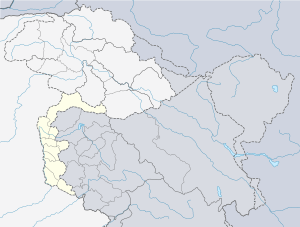Chirala, Azad Kashmir
Chirala is a village and Union Council of Dhirkot Tehsil in the Bagh District of Azad Kashmir.
Chirala | |
|---|---|
Union council | |
 Chirala | |
| Coordinates: 33.967823°N 73.578047°E | |
| Country | |
| State | Azad Kashmir |
| District | Bagh |
| Tehsil | Dhirkot |
| Government | |
| • MLA | Sardar Attique Ahmed Khan (Muslim Conference) |
| Population | |
| • Total | 6,059 |
History
Prior to 1947, Chirala had a military outpost of the Jammu and Kashmir State Forces. In October 1947, it was held by two Gorkha companies of the 7th Battalion of the State Forces, commanded by Captains Dalbir Singh and Lachman Dass. At the beginning of the October, the post was attacked by the Poonch rebels and subjected to "continuous mortar and medium machine-gun fire".[1]
Reinforcements were sent from Srinagar on 3 October, consisting of two companies of the 8th Battalion under Lt. Col. Maluk Singh . After passing Kohala, the force found that "every ridge, hilltop and track-bend" was held by the rebels offering stiff resistance. The reinforcements eventually reached the post on 7 October and evacuated the Gorkhas and the refugees taking shelter there. En route to Bagh, the forces again faced rebels along the way. After a stiff fight at Arja, they eventually reached Bagh on 13 October. Abdul Haq Suharwardy states that the rebel resistance was organised by Sardar Abdul Qayyum Khan.[1][2]
Chirala thus came into the rebel hands and became part of Azad Kashmir.
Tribes and groups
The majority of the inhabitants of UC Chirala are the ڈھونڈ they call themselves عباسی. Other tribes such as the Syed, Awan, Raja Hashmi Qurashi etc.) also inhabit the area in smaller proportion. The main families of
Political parties
The main political parties from this area are JKLF, Muslim Conference, Jamaat e Islami, and PML (N).
Attique Ahmed Khan is the Member of the Legislative Assembly of Azad Kashmir (MLA) representing the area.[3] His opponent was Major(Retired) Latif Abbasi.
References
- Singh, K. Brahma (2010) [first published Lancer International 1990], History of Jammu and Kashmir Rifles, 1820-1956: The State Force Background (PDF), brahmasingh.co.nf, pp. 221–222, ISBN 978-81-7062-091-4, archived from the original (PDF) on 2016-03-06, retrieved 2018-05-28
- Suharwardy, Abdul Haq (1983), Tragedy in Kashmir, Lahore: Wajidalis, p. 108
- Members AJK Legislative Assembly 2016 to till now Archived 2015-09-23 at the Wayback Machine, Legislative Assembly of Azad Jammu & Kashmir, retrieved 28 May 2018